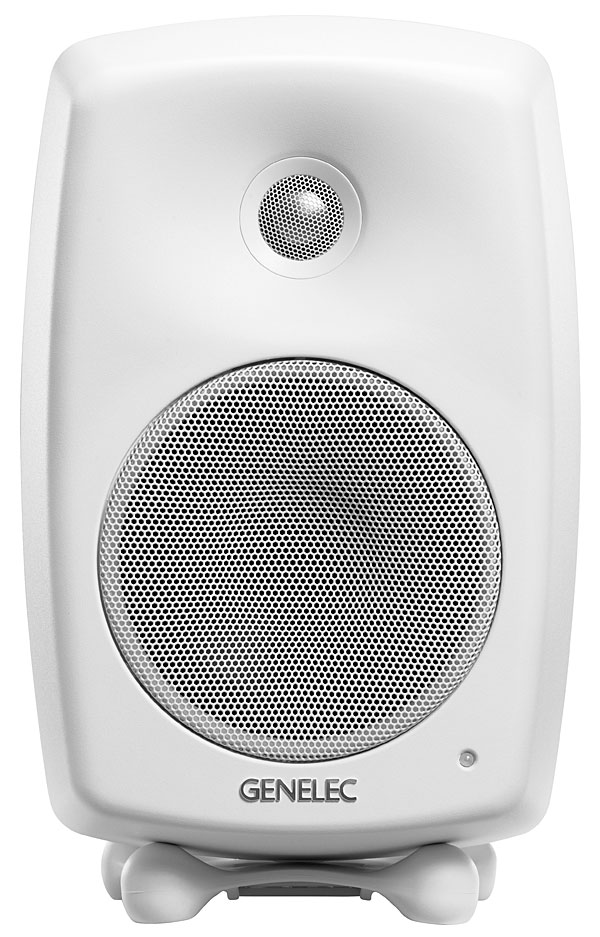| Columns Retired Columns & Blogs |
Herb,
Did you use the Genelec G Three with a wireless streamer?
By driving a loudspeaker's voice-coil directly from the output of a dedicated power amplifier, a designer can avoid many of the problems that occur in passive speakers due to the impedance mismatches among the amplifier, speaker cables, and various voice-coils. Passive crossover networks employ large, expensive inductors, high-watt resistors, and fat film capacitors. By necessity, the design of passive crossovers leaves aspects of the amplifier-loudspeaker interface to chance.
Crossovers in active speakers are usually integrated just ahead (or sometimes inside) the power amplifier's circuitry and use smaller, less-expensive parts; the designer has more control over gain and EQ. Well-designed active speakers can achieve more predictable, consistent outcomes.
My ears declared that the active filters in the G Three seem more invisible—that they were doing less harm to the sound—than the crossovers in my sealed-box Falcons. All levels of dynamics, micro to macro, appeared less smeared and compressed than they do through GoldenEar's BRX, KEF's LS50, and my beloved Falcons. This dynamic clarity made recordings sound more relaxed, unhampered, and natural-flowing than through my Falcons powered by the Pass Labs XA25.
This uncompressed transparency was especially evident with Cardas's Clear Beyond cables connecting the Genelecs directly to the dCS Bartók DAC/streamer. (See my report in this month's Gramophone Dreams.) I found that the punch, power, transparency, apparent speed, and dynamic ease of the G Threes improved dramatically when I switched from Cardas's entry-level Iridium ($125 for a 1m pair) to their flagship Clear Beyond interconnects, which, at $4250 for a 1m length, cost a lot more than a pair of G Threes. The Bartók–Beyond–G Three system sounded like a complete, high-resolution, end-game audio ensemble that could give long-term pleasure to even the most discriminating audiophiles.

Fed by the Bartók, with the Clear Beyond interconnects, the G Three's natural-feeling transparency took the song "Melena," from the album Será una Noche, performed by La Segunda (24/96 AIFF, M•A Recordings), to a place of pure, unadulterated beauty, where I could feel the air pressurizing the recording venue. The sound on this spectacular Todd Garfinkle recording carried all the music's mesmerizing force. The magic resulting from Todd's mike placement was on full display. With the Bartók/Beyond/G Three combination, nothing felt like too much or too little. The enchanting, rhythm-enhancing echo on "Taquito Militar" seemed precisely described—not truncated, exaggerated, or smeared.
The most immediate aspect of the G Three's sound was its unspoiled clarity, which reminded me of the unobstructed view I experienced with the crossoverless, full-range EJ Jordan Marlow. In my small room, the Genelecs sounded less raw and direct but just as clear—and bigger (soundspace-wise)—than the Marlows, with more energy and solidity at the frequency extremes.

When I returned to the LS3/5a
I'd been quite happily playing everything through the G Threes for about three weeks when a Stereophile reader named Aaron Garret recommended the album Air from a London-based group called Sault, which is led by Great Britain's Producer of the Year, Dean Josiah Cover, who also goes by Inflo (16/44.1 FLAC, Forever Living Originals/Qobuz). I had never heard of Sault, or Inflo, but I immediately fell for Air's edgy, noisy, choir-and-sound-collage unpredictability. Even more, I enjoyed Sault's melodramatic, Hollywood-esque film-score ironies and the way the album used strange, contrasting sounds to confront and challenge me.
When I played Air's first several tracks through the Genelec G Threes, the volumes of air around vocals and synthesizer seemed excessively dense and closed in. I wasn't sure whether this thick mechanical texture I was noticing was an aspect of the recording or an artifact of the G Threes.
Soon, though, it became clear that I was hearing fake reverb-glue, which infused the whole recording. The various layered tracks (most featuring synthesizers) and heavily compressed movie-score orchestrations, set behind the equally compressed voices of the Music Confectionery choir, cried out for air and dimensionality. Alas, there was no air in Air; the album couldn't breathe. This music is good, but these Genelec G Threes did nothing to disguise Inflo's suffocating, effects-heavy production.
When I played this odd-sounding album through my Falcon Gold Badges, powered by Pass Labs' XA25, the sound opened up—a little. The tones of everything became slightly drier but also more saturated. The Falcons made this album more enjoyable. Some bit of Air's unsupple density was either exaggerated by or more clearly revealed by the Genelecs.
As I compared more albums through the G Threes and Falcons, though, it became apparent that the Genelecs emphasized detail more than the similar-sized LS3/5a's. With the G Threes, I could hear more of the nuts and bolts of album mixes. That extra insightfulness was one of the G Three's defining characteristics. Who doesn't like beauty and resolution, together?

There was one other time that the G Threes sounded different than I reasoned they should. I was listening to Cheng Gong Liang play "Melody of Contemplation" on Guqin (16/44.1 FLAC, Wind Music/Tidal). This album, which I know very well, was recorded by master recordist Kavichandran Alexander. Through the G Threes, it was moister and rounder and less precisely defined than with my Falcons, which play it with more transient bite, more clearly defined form, and stronger pluck. I have no explanation for this apparent inconsistency.
When I strained to listen critically, I noticed only one shortfall with the Genelecs, and it was minor. To my ears, the G Three's presentation was slightly ethereal—less of the Earth—than the more corporeal Falcon LS3/5a Gold Badges. Maybe the Genelec's cast-aluminum enclosure made me miss the flavor of the Brit speaker's wood box? I suspect the G Three's metal cabinet contributed more than a little to my impression of purity in its sound.
Sequence is everything. Each time I switched from the five-times-more-expensive Falcon/XA25 combo to the active Genelecs, on every recording I played I noticed the beauty of the G Threes' clear-lens resolve and their conspicuous purity. When I switched from the Genelecs to the Falcons, I noticed their surprising weight and natural tone.
Audiophile for life
Being an audiophile for life has been an odyssey of self-discovery, learning where to direct my listening attentions, what to care about, what to admire. I've learned to be a fan of audio companies that have stood the test of time; whose products have become esteemed classics by delivering high levels of long-term musical engagement, whose attitudes and engineering viewpoints reflect my values, and whose house sound feels insightful and true to the arts of music and recording. It's partially a style thing, but I've always been attracted to products with a recording studio/movie theater pedigree that looked sturdy and performed in an unfussy, professional manner. To my taste, too many of today's home hi-fi components are often too fluffy and bourgeois-looking, too much about ersatz "hi-fi" sound and glitzy trophy-product styling—all the more reason to appreciate affordable, professional-looking gear like the Genelec G Three.

I've long railed against speakers that need to be placed far away from room boundaries so that they can be listened to in some Eames-chair sweet spot even farther into the room. Consequently, I am a life-long advocate of nearfield listening and small, nearfield-monitor–type speakers. In this respect, too, the G Three matches my values.
I doubt you'll be surprised when I tell you I am over-the-moon crazy about Genelec's G Three minimonitor. It rendered recordings in a manner that really suits my listening proclivities.
And filled with song was the air
Genelec's G Three transduces more unpolluted truth than any other small speaker I've auditioned. Its unique purity is mesmerizing, a pleasure to hear. In my room, with my sources and preamp and wires, the G Three performs like an authentic studio monitor, providing copious detail without losing any of music's beauty or poetic content. My highest recommendation

Herb,
Did you use the Genelec G Three with a wireless streamer?

A RaspberryPI with a DAC hat would work, an old Apple Airport Express would work as well.

HR: I took a look at the setup for Falcons but didn't see a distance from listening position (guessing around 65" based on distance between the speakers). Perhaps I missed it. I am curious about your distance from the G3s and whether they'd work in a more conventional two channel set up?

only 5-7 feet from the Falcons; but I imagine the G3s would work almost anywhere in most any room that is not too big. They can play loud and soft without distorting. And they are EQ adjustable.
h

Herb,
Did you use the G3s with a wireless streamer?
I have pairs of Audioquest Sydney RCA sitting around waiting for action.
Paul
UWS

..is that it proves, without a doubt, the accuracy of JA's measurements.

and HR. Too few understand without them.
It's funny it seems that their words only matter when measurements are provided... even more so when those measurements are positive.
Trust is rare thing these days. Sad.

Read about these Genelecs on Audio Science Review and bought them based on the detailed review and recommendation. Couldn't be happier. Prompted me to sell my Klipsches, Omegas, Sonus fabers, Vandersteens, Pass Labs, Haflers. BTW unlike certain opinion and suggestion based web magazines who shall remain nameless, ASR puts it all out there for the customer to take in and digest. No profit motive, no adverts, no smoke and mirrors and no hoary Golden Ears declaiming what "Audio Should Be!" in their biased, befuddled and financially conflicted opinions.
Truth is a rare things these days. Sad.

Smug retorts need substance. ASR puts out measurements and the only judgment Amir passes is measurement based only.
Moreover, what everyone buys on the ASR's site IS the best measuring gear and ONLY that. Another lie.
Other pretending that there's a recommendation based on sound in his writing is an obvious lie.
No one in this magazine tells 'what you should buy'. Only you and the posters on ASR believe that bs. You make up stuff just like the misinformation you consume. Stereophile even has a emphatic statement of this in their recommended components for the past 20 + years. (Where they don't tell you what you should buy ever..)
Hoary Golden Ears? You're nuts if you think TAS was ever serious about that. But you're looking only for the negative, much like all of the ASR cultists instead of being transparent and losing your anti-social attitude.
There is room for all of us. But don't bs anyone here.
And lastly before you use my language to feign smugness, look at your message and find the actual truth.

I never commented to the negative about Genelec speakers in any way, shape or form.
Stereophile provides both listening reviews and measurements. That too me is far more comprehensive and wrought over decades of experience. ASR can't claim either.
And semi-personally, I wonder why you would buy anything without a return policy. Sounds like you don't trust your ears, cause that's a lot of gear selling... and it also sounds like you sold a lot when a lot of other factors could have been addressed. Cables included.
What is out today is far more engineered with better technology, across the entire industry and globe. Decrying gear from decades ago is obvious and indicative of that time period.

Well done sir. A reply composed entirely of straw man fallacies! Voice of America should be proud of such talent!
Further thoughts:
Do people in advertising even go to college? If yes, do they dropout early due to "personal reasons"?
Foods for thought Herb, John, ...Fremer, et al: "Wherefore by their fruits ye shall know them. By Their actions shall you know them."
-St. Peter Aczel @ Matthew 7:20.
Yea Friends, let us not forget St. Peter Aczel @ Matthew 7:15:
"Beware of false prophets, which come to you in sheep's clothing, but inwardly they are ravening wolves."
Perhaps ye shall repent your ways and beg forgiveness of the multitude. Perhaps not.
Regardless, I wish ye all peace and humility in your journey to the stars!
-P_T

It smells quite foul. And you so valiantly almost-argue yourself out of the paper bag.
What happens when Amir kicks it or no longer wants to produce report after report correlating sound quality based on measurements? Are you hoping another other semi-retired guy who likes performing tests more than listening to music can find all of the time it takes to produce hundreds of 'reviews'? And gosh I really hope that person never creates a false narrative while producing those pictures and graphs (like ASR).
I could only wish. Instead, this magazine realizes the environment that every American must weather and succeed in (especially in the age of the internet).
We as consumers that actually buy stereo equipment must endure the woeful deluge of commercial assault and wade through the murky waters of marketing to find the truth in music.
Fortunately, we have trusted journalists that respect the livelihood of cottage-industry engineers and business owners that create the gear we buy. They tell the truth, but they respect the company and designer that has put their entire lives on the line to produce bespoke audio components.
They do this by focusing on the positive, active listening for musical enjoyment, rather than decrying a product based on speculative and theoretical suppositions.
It's the concept of listening and reporting with measurements versus implicating components based on a limited and inadequate measurement group and then arbitrarily spewing value on a small subset of objective findings.
A $12,000 preamp with worse measurements than my $3000 Benchmark HPA-4 will still sound better 9 times out of 10.
When parts quality goes up, the 'immeasurables' become more audible.

That you are the only 'sucker' in the room... (See P.T.'s laundry list of sold, used-components that he was never happy with.)
"Prompted me to sell my Klipsches, Omegas, Sonus fabers, Vandersteens, Pass Labs, Haflers."
Full Circle Burn.
Lol.

My butler tells me I may have hurt your feelings with my plain speaking.
To that I say "Toughen up buttercup!" Life isn't for the faint or weak hearted. Anyone sitting around with enough time on her hands to reply twice to singular postings clearly doesn't have enough to do Karen.
Get a dog. Join a bridge club. Tutor an underprivileged child. There's a whole bright shiny world out there.
But YOU have to take the first step.


Thank you Herb and John Atkinson for this brilliant analysis. It is hard to imagine the Audio Realism level delivered by diverse Genelec active speakers and their GML software can be matched or exceed by any loudspeaker / amp combination from traditional "HiFi/Audiophile" brands.
We are in fact considering to deploy Genelec 8320A 4 inch Powered Studio Monitor (SAM) and Genelec 7350A 8 inch Powered Studio Subwoofer with GLM software as reference in our "Hi-Reality Machine" prototype #5.
Regards, Babak
Founder, Hi-Reality Machine
Youtube channel: Hi-Reality Sensorium

Nice review.
But, the song 'Melena' is not on my album "Sera Una Noche"! Maybe you meant another one?
Very beautiful music of Cheng Gong Liang. The instrument played is a cither called ghuzeng in China. About the same cither in Korean, is called 'gayageum', and in Japanese: 'koto'.
More of this instrument: Liu Fang, who also plays pipa, and also in Korean music are many beautiful pieces, on gayageum.
"Sault" is very special, indeed.


Man, these are some ugly looking speakers.

Not to my eyes. The raw aluminum version has a Frank Gehry-like form that reminds me of the Guggenheim Museum Bilboa. Not sure how it looks in person but I think it looks great in the picture I have seen.

Such outstanding performance as noted by both the reviewer and the technician and yet none dare call them "Reference Speakers" despite that fact that's how they are used by recording studios and their objective performance clearly dictates. Pray tell what must these highly engineered and competent speakers provide to be included in that hallowed list? Is it sweet kickbacks to the editor? Free trips for the reviewer and technician? Splashly full page ads in the print magoo?
Do tell...

Those are the ugliest speakers I have ever had the misfortune of laying eyes on! They look like something from around 1984 to use with your Atari video games... Just sayin'. ;)

[please forgive my poor English]
Hello all, I am a new member here (Stereophile reader since a long time though).
Thanks Herb for your review. Always a pleasure to read you.
When I saw the anechoic response of the active G Three, measured by JA, I immediately recognized a similarity with the passive Harbeth M30.2 Anniversary's response (that you reviewed in Mar 2018, and rated as 'class A - restricted LF' speakers). I could not wait, I had to check at once, and I found back JA's measurements in a snap.
Indeed, except that the Genelec have a somewhat smoother low-mid/bass-emphasis, it seems (to me at least) that there is a similarity between the repective anechoic response of each speaker, especially taking the Genelec measured on HF axis (see green curve: had Genelec wished to mimic a BBC-dip around the 3 KHz region, they might not have acted otherwise; of course, I am not suggesting that mimicking a BBC-dip was Genelec's goal, nor that yet another debate about the BBC-dip should be triggered again).
Genelec G Three anechoic response. ACTIVE
Cf. Anechoic response on HF axis at 50" (green)
Stereophile Aug 2022
Harbeth M30.2 Anniversary - PASSIVE
Stereophile Mar 2018
Herb, did you have the opportunity to compare (even 'privately') the Genelec G Three with the Harbeth M30.2 Anniversary?
(you may no longer have the M30.2 under the hand).
I am aware that comparing a passive with an active speaker has limited pertinence, as an amplifier has to be used to do so in the case of the passive, which acts as an unpredictable variable (and, for sure, on other measurements than anechoic IRR, we all can note that the two speakers are dissimilar).
It is also possible that a large part of the difference between G Three's and M30.2's Anniversary lies in the presentation: more forward and "monitoring" for G Three, more "mid-hall" for the M30.2, both delivering musical rendition that would be considered as enjoyable by the same listener, each speaker giving him the feeling to sit on a different seat in the same concert hall. BUT, the differences may be much greater than that. Therefore my question.
CONTEXT
I own a pair of M30.2 Anniversary quickly bought for the hasty setup of a 2nd system in the countryside, during the lockdowns, in order to survive musically speaking. They are setup in a 40m² former stable, made of brick wall with a ceiling made of curvated little vaults; the room acoustics is astounding. I initially did not figured out "how much" I would survive thanks to those little marvels on classical music, the most demanding of all (I attend live acoustic, unamplified, performances nearly each week, in the best seats of the best concerts halls - it fine-tuned my ear-brain over the years; as I am still young, as I obsessively protected my ears while I went in clubs, I am still very demanding regarding treble, its naturalness, and its flawless integration with the medium; the latter being preferably to-die-for; as for bass: as soon as cello is more or less OK or vaguely credible, I am happy).
I do not intend to switch, or ditch the M30.2. I just wondered if we could achieve a similar result with the Genelec G Three as a commmon gift for a girlfriend's birthday (or for myself, in a 3rd system in an office/sleeping with wobbling wood floor and walls; tone controls could be welcome here).
PS: I struggled with the HTML tags by respect of all members' eyes; so I HOPE that the link to my hosted picture will pass...
Kind regards from Europe.
Orfeo

I did compare them to the Harbeth 30.2s and yes they do sound alike. They both have that 'monitor sound' that I tend to favor. But the active G3s are more subtle and more dynamically awake than most any passive box speaker I've encountered.
kind regards from Brooklyn,
hr

Hello Herb, thank you for the great review! By the way, you mentioned the Kef LSX's. Are the Genelecs better? I currently have the LSX connected to my TV, and I'm debating whether I should move them to my desktop and purchase something better like the LS50, or leave them there and buy the G Threes. Since most of my music listening is while I'm working, I prefer better sound on my desktop rather than from the TV. Would you choose the G Threes and F Two over the LSX and SVS SB-1000? Thanks.

Thanks for yet another great review! After reading it I ordered a pair of G3s (in raw of course) as I did with the Falcon LS3/5As after reading THAT review. These speakers are truly amazing - especially when you hook them up to a top notch pre-amp (in my case an Ayre) and serious cables (Shunyata Alpha v2s). I also added a small sub from SVS. The sound that they can produce with great sources, preamp and cables is simply stunning (at least in a smallish room). Now I am considering the bigger Genelecs - but perhaps I should wait for a Herb review first to get in buying mode... :-)